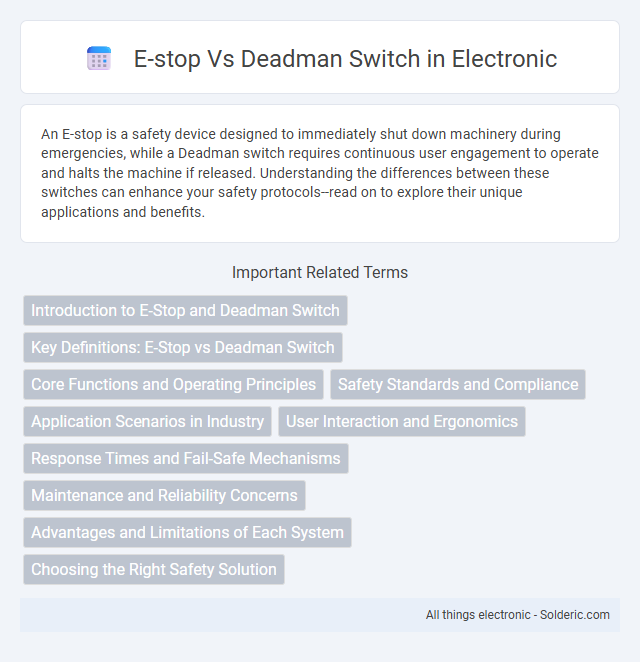An E-stop is a safety device designed to immediately shut down machinery during emergencies, while a Deadman switch requires continuous user engagement to operate and halts the machine if released. Understanding the differences between these switches can enhance your safety protocols--read on to explore their unique applications and benefits.
Comparison Table
| Feature | E-stop (Emergency Stop) | Deadman Switch |
|---|---|---|
| Purpose | Immediate shutdown of machinery during emergencies | Continuous operator presence confirmation for machine operation |
| Operation | Activated by pressing a button or pulling a lever | Activated by constant pressure or grip; deactivates if released |
| Use Case | Emergency scenarios requiring quick stop | Safety mechanism for preventing unintended operation |
| Reset Method | Manual reset after hazard clearance | Automatically re-engaged when operator applies pressure |
| Common Industries | Manufacturing, automation, heavy machinery | Railways, construction equipment, handheld tools |
| Safety Compliance | Required by OSHA, ISO standards for emergency stops | Complies with regulations for operator presence controls |
Introduction to E-Stop and Deadman Switch
E-Stop and Deadman switches are critical safety devices used to halt machinery and prevent accidents in industrial environments. An E-Stop (Emergency Stop) is a manual, easily accessible button that immediately cuts power to equipment, ensuring rapid shutdown during emergencies. The Deadman switch requires continuous pressure or presence from the user, automatically stopping the machine if released, safeguarding operators who may lose control or become incapacitated.
Key Definitions: E-Stop vs Deadman Switch
An E-Stop (Emergency Stop) is a safety device designed to immediately halt machine operations in hazardous situations to prevent accidents. A Deadman switch requires continuous physical input from the operator, such as holding a button or lever, to keep a machine running and automatically stops it if the operator releases control. Understanding these fundamental differences helps ensure your machinery safety protocols effectively address both emergency shutdowns and operator presence monitoring.
Core Functions and Operating Principles
The E-stop (Emergency Stop) is designed to immediately halt machinery or processes by cutting power to ensure safety during emergencies, operating through a simple, highly accessible push-button mechanism. The Deadman switch requires continuous pressure or engagement from an operator to keep equipment running, automatically stopping operations if the control is released, ensuring active human presence. Both devices serve critical safety roles but differ in activation: the E-stop is a reactive safety measure, while the Deadman switch is a proactive control ensuring operator vigilance.
Safety Standards and Compliance
E-stop (Emergency Stop) and Deadman switches are critical safety components designed to comply with international safety standards such as ISO 13850 and ISO 13851, respectively. E-stops provide immediate machine shutdown for emergency intervention, meeting stringent requirements for accessibility, reliability, and fail-safe operation. Deadman switches ensure continuous operator engagement, complying with industrial safety regulations for hazard containment during motion or operation, minimizing the risk of unintended machine activity.
Application Scenarios in Industry
E-stops are crucial in industrial machinery for immediate shutdown during emergencies, ensuring worker safety and preventing equipment damage in automated manufacturing lines and heavy machinery operation. Deadman switches are predominantly used in transportation and lifting equipment, requiring continuous operator engagement to maintain movement, commonly found in forklifts and cranes to prevent accidents if the operator loses control. Both devices enhance operational safety but are tailored to distinct scenarios: E-stops serve as panic buttons for rapid halts, while deadman switches ensure active human control during machine operations.
User Interaction and Ergonomics
E-stop buttons provide immediate, easily accessible emergency shutdown with a large, clearly marked design for quick activation. Deadman switches require continuous pressure or grip, ensuring the user's constant engagement and reducing the risk of unattended operation. Your choice depends on whether rapid, one-time intervention or sustained user presence is critical for your safety system.
Response Times and Fail-Safe Mechanisms
E-stop switches typically offer instant response times by cutting power immediately upon activation, ensuring rapid system shutdown for safety. Deadman switches require continuous user engagement to keep machinery running, automatically stopping operations within milliseconds if released, providing a proactive fail-safe mechanism. Your choice between these devices should reflect the operational context and the criticality of minimizing response times while maintaining fail-safe functionality.
Maintenance and Reliability Concerns
E-stop switches are designed for emergency shutdowns and require regular inspections to ensure functionality, as failure could lead to severe safety hazards. Deadman switches demand consistent maintenance to verify responsiveness since their reliability directly influences continuous operator control and system shutdown in case of operator incapacity. Ensuring proper servicing of both devices enhances your overall safety system's dependability and minimizes unexpected downtime.
Advantages and Limitations of Each System
E-stops provide immediate shutdown of machinery, ensuring rapid response during emergencies and minimizing accident risks, but they may cause abrupt halts that can damage equipment or processes. Deadman switches offer continuous operator presence monitoring, enhancing safety by requiring active engagement, yet they rely on human attention and may fail if the operator becomes incapacitated without releasing the switch. Your choice between these systems depends on whether quick emergency stops or ongoing operator control aligns better with your safety protocols and operational needs.
Choosing the Right Safety Solution
Choosing the right safety solution between an E-stop and a Deadman switch depends on the specific operational context and risk level. E-stops provide immediate machine shutdown during emergencies, ideal for hazardous environments requiring rapid intervention, while Deadman switches ensure continuous operator presence and control, enhancing safety in applications involving sustained manual input. Evaluating the equipment's function, user interaction, and emergency scenarios ensures the selected switch maximizes safety and compliance with industry safety standards.
E-stop vs Deadman switch Infographic

 solderic.com
solderic.com